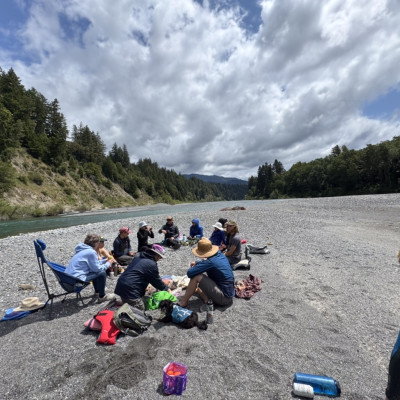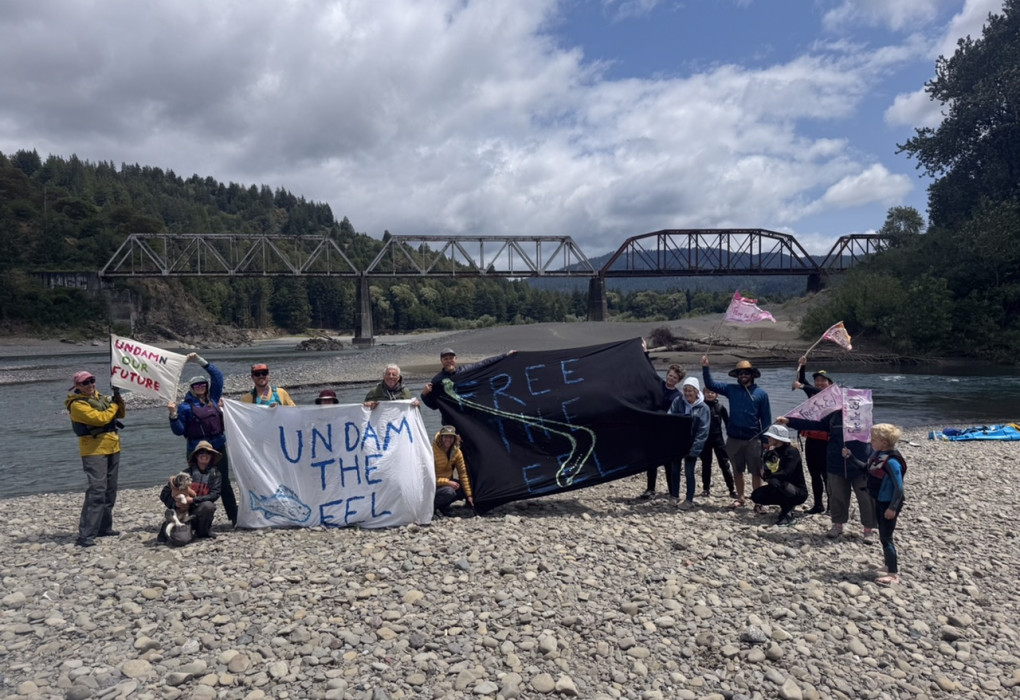StEELhead Discoveries Series - Part 17: June 2025
*This is Part 17 of an ongoing series on the campaign to Free the Eel and efforts to better understand and revive the iconic steelhead in the Pacific Northwest by Native Fish Society Fellow Samantha Kannry. View all parts of this series HERE. Additional parts and updates will be posted over the next several months. Stay tuned!
~ ~ ~ ~ ~ ~
On May 17th, we had our second annual Free the Eel float. We floated the same stretch as last year, from the small community of McCann to the confluence with the South Fork at Dyerville. This pleasant, yet infrequently run section is around 7 miles of class I riffles and pools. This year was a true family affair, with over half of the people joining having at least one relative present. Many of the folks that came along had rarely (if ever) paddled down a river, but were excited to get a little float in. We had a mixture of rafts, catarafts, drift boats, inflatable kayaks and packrafts. All crafts had a tough time pushing through the persistent upriver wind, particularly nearing the confluence. My own windy ride was remarkable, in a packraft (as we ran out of spots in better flatwater crafts for everyone), and with only half a paddle, as a friend had ended up with mismatched halves, so I gave them mine. Everyone made it to the takeout with smiles on their faces and sand in their toes and a renewed desire to “Free the Eel, Let her flow, Give her back her mojo” (spoken by an intrepid participant of a previous float).
Along the way we discussed the decommissioning process, hatchery proposals and alternative options, and friends floating the entirety of the undammed Klamath and what that would be like in the future on the Eel. During the decommissioning proceedings there is an opportunity to make substantive changes to the future of fisheries management in the basin and to select restoration goals to focus resources on.
As humans with analytical minds and empathic dispositions, there is a tendency to feel a need to do something to make things better. This well-meaning approach can often have unforeseen or poorly understood consequences. Putting more fish in the river (in the form of hatcheries or hatch boxes) or moving fish around or away from hazardous sediment plumes with dam removal are usually done with good intentions. Put more fish in the river and there will be more fish in the river; help fish bypass bad water quality and they will be in the clear, right?
If there is one thing we can say for sure after more than a century of fisheries management in the Pacific Northwest, it is that we humans do not agree upon what is best for long-term recovery of fish populations, and that our active approach to rebuilding wild populations is not working. A recent meta-analysis published in the journal “Fisheries Ecology and Management” found that of over 200 studies looking at the effects of hatcheries on wild fish populations, 83% of the examined programs had an adverse effect on wild fish. Of the remainder, only 3% reported beneficial effects on wild fish. Further tweaking and improving our current methods will only get us so far. You can’t make a silk purse out of a sow’s ear. Hope you can join us next year on the Free the Eel float to discuss such matters!


~~~~~
About the Author:
Samantha Kannry has been monitoring, studying, and swimming with summer-run steelhead in the Eel River and other rivers of Northwestern California for the past thirteen years. She joined NFS as a volunteer in 2015, then became a fish genetics fellow in 2020.
While it has been clear to the native peoples of the region since time immemorial that summer-run steelhead and the congeneric spring Chinook are separate populations, not everyone else sees it so clearly. Her research has focused on using conservation genetic tools to elucidate the distinction between summer and winter-run steelhead.
When not minking (a combination of hiking, swimming, snorkeling, sliding, shimmying, and boulder jumping) down rivers, she is usually growing and eating fruit, moving manure at Caudal Fin Farm, or bike touring distances large and small. All working towards re-establishing the inherent continuity between rivers, land, and people.
Read StEELhead Discoveries Part 1 - 16 HERE.

